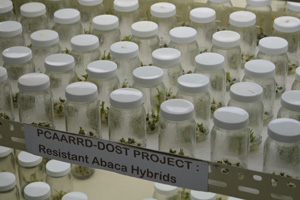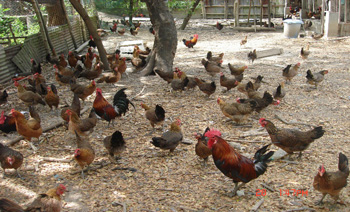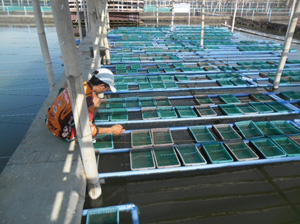 The Philippine Council for Agriculture, Aquatic and Natural Resources Research and Development (PCAARRD) of the Department of Science and Technology (DOST) will showcase the best of its agri-aqua research and development (R&D) outputs generated from 2010 to 2016 in an event dubbed as SIPAG FIESTA on March 2 to 4.
The Philippine Council for Agriculture, Aquatic and Natural Resources Research and Development (PCAARRD) of the Department of Science and Technology (DOST) will showcase the best of its agri-aqua research and development (R&D) outputs generated from 2010 to 2016 in an event dubbed as SIPAG FIESTA on March 2 to 4.
SIPAG reflects the vision and direction of S&T as laid down in the Council’s Strategic Industry S&T Program for Agri-Aqua Growth (SIPAG). It also embodies the Council’s commitment to Outcome One of DOST-PCAARRD in a bid to ensure that the fruits of R&D activities for the said sectors will be a blessing for every Juan, in keeping with the President’s social contract.  Outcome One, the foremost of DOST’s eight major Outcomes, seeks to provide the agri-aqua sectors with science-based know-how and tools that will enable the said sectors to raise productivity to world-class standards.
Outcome One, the foremost of DOST’s eight major Outcomes, seeks to provide the agri-aqua sectors with science-based know-how and tools that will enable the said sectors to raise productivity to world-class standards.
Meanwhile, DOST-PCAARRD’s Farms and Industry Encounters through the Science and Technology Agenda or FIESTA, one of the Council’s technology diffusion strategies, typifies a fiesta atmosphere created to enhance agri-aqua technology transfer and commercialization.
DOST-PCAARRD uses FIESTA as a technology transfer strategy, inasmuch as the venue can effectively showcase the various R&D initiatives of government research institutions in the form of agri-aqua technology or products. These products are certainly common in every Fiesta celebration, hence a profitable venue for micro, small, and medium enterprises.
Government research institutions engaged in agri-aqua concerns, have generated a wide array of technology that has either improved or provided significant outputs. Among such outputs are on food delicacies, processed or food products, wines, grains, fruits, meat, and vegetables - agriculture products that complement a true fiesta celebration.  SIPAG FIESTA will feature exhibits, techno forum, techno demo, and other ancillary activities to showcase the best R&D outputs of the Council and its partners. Most importantly it shall serve as a venue for market matching and commercialization of S&T-based technologies and products.
SIPAG FIESTA will feature exhibits, techno forum, techno demo, and other ancillary activities to showcase the best R&D outputs of the Council and its partners. Most importantly it shall serve as a venue for market matching and commercialization of S&T-based technologies and products.
DOST-PCAARRD has identified eight notable technologies that will be highlighted during the SIPAG FIESTA. These technologies are: carrageenan plant growth regulator (CPGR); improved Lakatan varieties resistant to Banana Bunchy Top Virus (BBTV) and Cavendish resistant to Fusarium Wilt; shrimp biofloc technology; Smarter Approaches to Reinvigorate Agriculture as an Industry in the Philippines or Smarter Agriculture; swine genomics, coconut somatic embryogenesis; rice mechanization; and asexual reproduction of corals for transplantation.
Developed by the DOST-Philippine Nuclear Research Institute (DOST-PNRI), CPGR is carrageenan extracted from seaweeds and further degraded using gamma radiation. In multi-location trials conducted in Bulacan, Nueva Ecija, Laguna, and Iloilo, CPGR applied at low concentrations in rice has been found to enhance the yield by 15–30%. Early this year, CPGR were distributed for free to 650 farmers in Pulilan, Bulacan and will be field tested in 2,000 hectares of rice field in Bulacan.
The University of the Philippines Los Baños (UPLB) has developed mutant lines of Lakatan through irradiation and are currently showing intermediate resistance to BBTV. Disease spread was observed to be slower in Lakatan lines compared to ordinary Lakatan. On the other hand, the program, S&T Management Approaches against Fusarium wilt on Cavendish in Mindanao, has identified the Giant Cavendish Tissue Culture Variant (GCTCV) 218 and 219 as moderately resistant and highly resistant to Fusarium Wilt, respectively.
Shrimp biofloc technology (BFT), which is implemented by the University of the Philippines Visayas UPV), uses a microbial mat composed of aggregates of bacteria, algae, protozoa, detritus, and dead organic particles. It can help reduce shrimp’s reliance on protein from feeds, stabilize water quality, improve shrimp’s nutrition, and control disease. Moreover, the technology results to larger shrimps as it enhances feed conversion ratio (FCR).
Implemented by UPLB, Smarter Agriculture aims to help farmers and decision makers to come up with sound and science-based judgements under certain situations. The project, which started in 2013, aims to provide the agricultural sector a decision support system (e.g. crop advisories, forecasts, and management) in dealing with climate change using advances in S&T.
To increase sow productivity, the application of gene marker was developed by the Philippine Carabao Center (PCC) and Bureau of Animal Industry (BAI) in partnership with the Accredited Swine Breeders Association of the Philippines (ASBAP). Ten gene marker protocols associated to high litter size, fast growth rate, and meat qualities as well as seven markers for screening of genetic defects and disease resistance were optimized. The adoption of the gene marker technology by the swine breeder farms is expected to increase productivity and efficiency in terms of number of pigs weaned and liveweight produced per sow per year.
Coconut somatic embryogenesis technology (CSet) is a tool for rapid mass propagation of superior genetic stocks for high yield, pest and disease resistance, and high value products. It is an alternative technique which involves the use of immature flowers, immature embryos, and plumule or the meristematic part of the embryo.
The CSet project is funded by DOST-PCAARRD and tested and evaluated by a group of researchers from the Philippine Coconut Authority (PCA), University of the Philippines (UP), Bicol University (BU), and Visayas State University (VSU).
To date, more than 12,000 plumules were excised and initiated for callus formation with 56% efficiency adopting the enhanced PCA-CSet protocol in seven upgraded/equipped laboratories. These are at PCA-Albay Research Center, PCA-Zamboanga Research Center, UP Los Baños (UPLB), UP Mindanao, Bicol University College of Agriculture and Forestry (BUCAF), and VSU.
The Rice Mechanization Program is a P65 million project that is expected to contribute to the reduction of rice harvesting and threshing losses from 4.2% to 1.8% in 2020. It will also help lower the losses from drying rice, from 5.8% to 3.8% in 2016.
The machines once developed and pilot-tested are expected to lower production costs and improve rice quality. Part of the Rice Mechanization program is the development of harvester and transplanter as well as a compact rice mill. These technologies were developed by the Metals Industry Research and Development Center (MIRDC) and the Philippine Center for Postharvest Development and Mechanization (PhilMech).
Corals asexual reproduction technology for reef restoration involves the collection of dislodged live coral fragments or “corals of opportunity” (COPs) and attaching them to coral nursery unit (CNUs) for quick recovery and regeneration to increase survival rates upon transplantation in degraded coral reef sites. Each CNU is designed to hold 500 COPs per batch and can be used several times a year.
Having started in 2012, the Filipinnovation on Coral Reef Restoration Program of DOST-PCAARRD has already established 538 CNUs and transplanted 487,158 coral fragments.
When the Filipinnovation program was completed in 2013, the National Coral Reef Rehabilitation Roll-Out Program continued the work using the same asexual reproduction technology that is now ongoing in nine sites across the country: Pagudpud, Ilocos Norte; Alaminos, Pangasinan; Bagac, Bataan; Subic Bay, Zambales; Puerto Princesa, Palawan; Anda, Bohol; Camiguin, Zamboanga City; and Kiamba, Sarangani. Overall, the two programs are now in 20 locations across 11 regions (1, 2, 3, 4A, 4B, 5, 6, 7, 9, 10, and ARMM).
Aside from the eight technologies mentioned, other technologies on various agricultural commodities will also be featured during the event.
One of the highlights of the SIPAG FIESTA is the maiden opening of the DOST-PCAARRD Innovation and Technology Center (DPITC). As a technology diffusion platform, among other functions, the DPITC will house a modern exhibition hub, a digital library, a conference facility, and a business hub.
